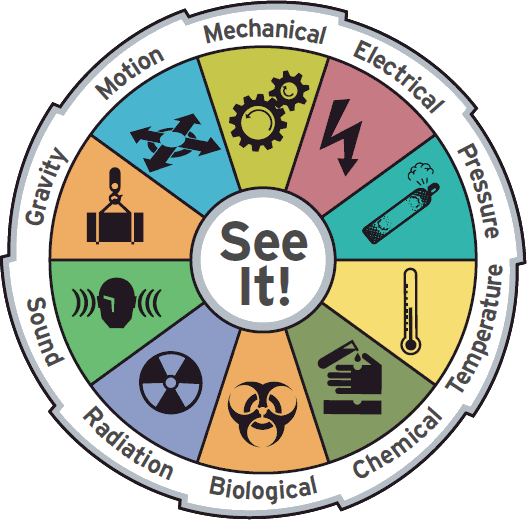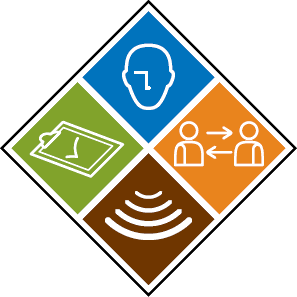
Chevrons Field Guide
Preventing
Serious Injury and Fatalities
Field Guide

Applying the Hazard
Identification Tool
Purpose
This field guide is a quick reference to help personnel involved in high-risk activities to identify and control the significant potential hazards unique to each activity and job.
This field guide supplements but does not replace existing permitting procedures and safe work practices. To keep it brief, not every potential hazard or prevention is listed. Apply appropriate local hazard assessment procedures, along with this guide, to comprehensively assess each job.
Field Guide Applications
- Before beginning your high-risk activity, review significant potential hazards and associated preventions.
- Refer to the field guide in all phases of hazard assessment.. during planning, permitting, implementingand closeout.
- Integrate this tool into local efforts on fatality and serious injury prevention.
- Build awareness among workers, supervisors and work leaders at meetings, field visits, shift turnovers and any other opportunity.
- Augment Managing Safe Work (MSW) field engagement and Contractor Health, Environment and Safety Management (CHESM) activities.
- Use during near-miss and incident investigations.
- Use as an Operational Excellence (OE) audit or self-audit tool for high-risk observations.
Preventing serious injuries and fatalities requires operational discipline. This means performing every task the right way every time, from initial hazard assessment through each step of the job, including post-activity review.
Hazard Identification Tool Definitions

Gravity
The force caused by the attraction of all other masses to the mass of the earth. Examples.. falling object, collapsing roof and a body tripping or falling.

Motion
The change in position of objects or substances. Examples.. vehicle, vessel or equipment movement; flowing water; wind and body positioning when lifting, straining or bending.

Mechanical
The energy of the components of a mechanical system, i.e., rotation, vibration or motion within an otherwise stationary piece of equipment or machinery. Examples.. rotating equipment, compressed springs, drive belts, conveyors and motors

Electrical
The presence and flow of an electric charge. Examples.. power lines, transformers, static charges, lightning, energized equipment, wiring and batteries

Pressure
Energy applied by a liquid or gas that has been compressed or is under a vacuum. Examples.. pressure piping, compressed cylinders, control lines, vessels, tanks, hoses and pneumatic and hydraulic equipment

Temperature
The measurement of differences in the thermal energy of objects or the environment which the human body senses as either heat or cold. Examples.. open flame; ignition Reference(s); hot or cold surfaces, liquids or gases; steam; friction; and general environmental and weather conditions

Chemical
The energy present in chemicals that inherently or through reaction has the potential to create a physical or health hazard to people. Examples.. flammable vapors, reactive hazards, carcinogens or other toxic compounds, corrosives, pyrophorics, combustibles, oxygen-deficient atmospheres, welding fumes and dusts

Biological
Living organisms that can present a hazard. Examples.. animals, bacteria, viruses, insects, blood-borne pathogens, improperly handled food and contaminated water

Radiation
The energy emitted from radioactive elements or source and naturally occurring radioactive materials (NORM). Examples.. lighting issues, welding arcs, solar rays, microwaves, lasers, X-rays and NORM scale

Sound
Sound is produced when a force causes an object or substance to vibrate and the energy is transferred through the substance in waves. Examples.. equipment noise, impact noise, vibration, high-pressure release and the impact of noise to communication
Abbreviations and Chemical Names
CHESM
Contractor Health, Environment and Safety Management
CO
carbon monoxide
CPR
cardiopulmonary resuscitation
GFCI
ground fault circuit interrupter
H2S
hydrogen sulfide
JHA
Job Hazard Analysis
JLA
Job Loss Analysis
JSA
Job Safety Analysis
LPSA
Loss Prevention Self Assessment
MOC
Management of Change
MSW
Managing Safe Work
N2
nitrogen gas
OE
Operational Excellence
OEMS
OE Management System
PFD
personal flotation device
PPE
personal protective equipment
PSP
Personal Safety Plan
PSV
pressure safety valve
RCD
residual current device
SWP
Safe Work Practices
TIF
Think Incident Free
Hazard Analysis, a Requirement for All High-Risk Tasks
We eliminate or mitigate risks by identifying hazards, taking actions to reduce them and sharing what we know. Hazard analyses must be conducted by qualified people for the type of work and its potential hazards. Analysis may include..
- Planning Phase Analysis such as Job Hazard Analysis (JHA), Safety Plan, Safety Instructions, Operating Procedures (with a review equivalent to a Planning Hazard Analysis), refinery instructions, review of safety plans, operator checklists or equivalent.
- Job Safety Analysis (JSA), Job Loss Analysis (JLA) and JHA or equivalent including onsite review.
- Personal hazard assessment tools, including Think Incident Free (TIF), Personal Safety Plan and Loss Prevention Self Assessment (LPSA) or equivalent.
Identify the Hazards and Take Action
- The first safeguard is you. To reduce the odds for human error, you must address any factors that may interfere with your readiness to perform well and to react effectively to unexpected events or changes.
- Review and follow the procedure for the task.
- Question what you would do in an emergency and include that information in the JSA document.
- Discuss the JSA with your co-workers to ensure it addresses the hazards associated with the work, that you understand what you will be doing and that you know how to do it safely.
- If the job changes.. Stop, evaluate and revise the JSA as needed. Don't make snap decisions.
Potential Significant Hazards
A potential significant hazard is any condition, action or object that has the potential for an unplanned release of, or unwanted contact with, an energy source that may result in a serious or fatal injury.
Energy source Hierarchy of Controls
Follow a hierarchy of controls approach to reduce the risk of a serious or fatal injury. Where possible, it is always best to first eliminate the hazard and then apply lowerlevel controls as needed. Based on the energy Reference(s), the hierarchy of controls is..
- Remove the energy Reference(s).
- Prevent the release of energy.
- Protect from the release.
- Use Stop-Work Authority.
Stop-Work Authority
All employees and contractors have the authority and responsibility to stop work that does not comply with the Tenets of Operation2 or that presents an imminent hazard - without the threat of reprisal. Perform these steps in sequence if you feel your own work or the work of others is not safe..
- Decide to intervene (take ownership).
- Stop the unsafe act.
- Notify immediate supervisors.
- Resolve the issue.
- Resume work (or stay shut down until risk is mitigated).
- Share what you learned.
Do it safely or not at all.
There is always time to do it right.
Human Performance
Human error has been shown to be a factor in nearly every serious incident and fatality. Your focus on improving human performance is critical to achieving an incident-free operation.

Distractions Can Happen to Anyone
In fact, the more familiar we are with the task, the easier it is to lose focus. Loss of focus can lead to an error. Even with established worker qualifications and the best tools and experience to guide us, we must also be personally ready to perform each job at our highest capacity.
The risk for error and injury goes up at all experience levels when individual or organizational factors, task demands or the work environment interfere with our ability to focus on our tasks.
Assess the Situation and Take Action
If you can answer "yes" to any of the assessment questions on the facing page, it may affect incidentfree job performance. Preventive actions you or your supervisor can take to reduce the risks to working safely include..
- Get help.
- Get clarification.
- Get focused.
- Defer the work.
Human Performance Assessment Questions

Individual Factors
- Are you feeling stressed, distracted or worried due to work or personal issues..
- Are you excessively fatigued or do you have many things distracting you from the task at hand..

Task Demands
- Are the procedures and instructions for the task unclear..
- Does the task require high concentration or multitasking..
- Does the task require more time than allowed..
- Are you capable of performing the task but feel that you require more guidance..

Organizational Factors
- Do you feel insecure about your ability to use Stop-Work Authority..
- Are you unclear about your roles and responsibilities..
- Are you uncomfortable communicating with your peers and supervisors..
- Do you feel pressured to take shortcuts..

Work Environment
- Is the environment (temperature, ventilation, room for movement, egress, lighting or noise level) different from what was expected or planned for..
- Are you in an environment prone to unanticipated distractions..
- Are you working in unpredictable or constantly changing conditions..
- Are labels, signs or displays inadequate..
